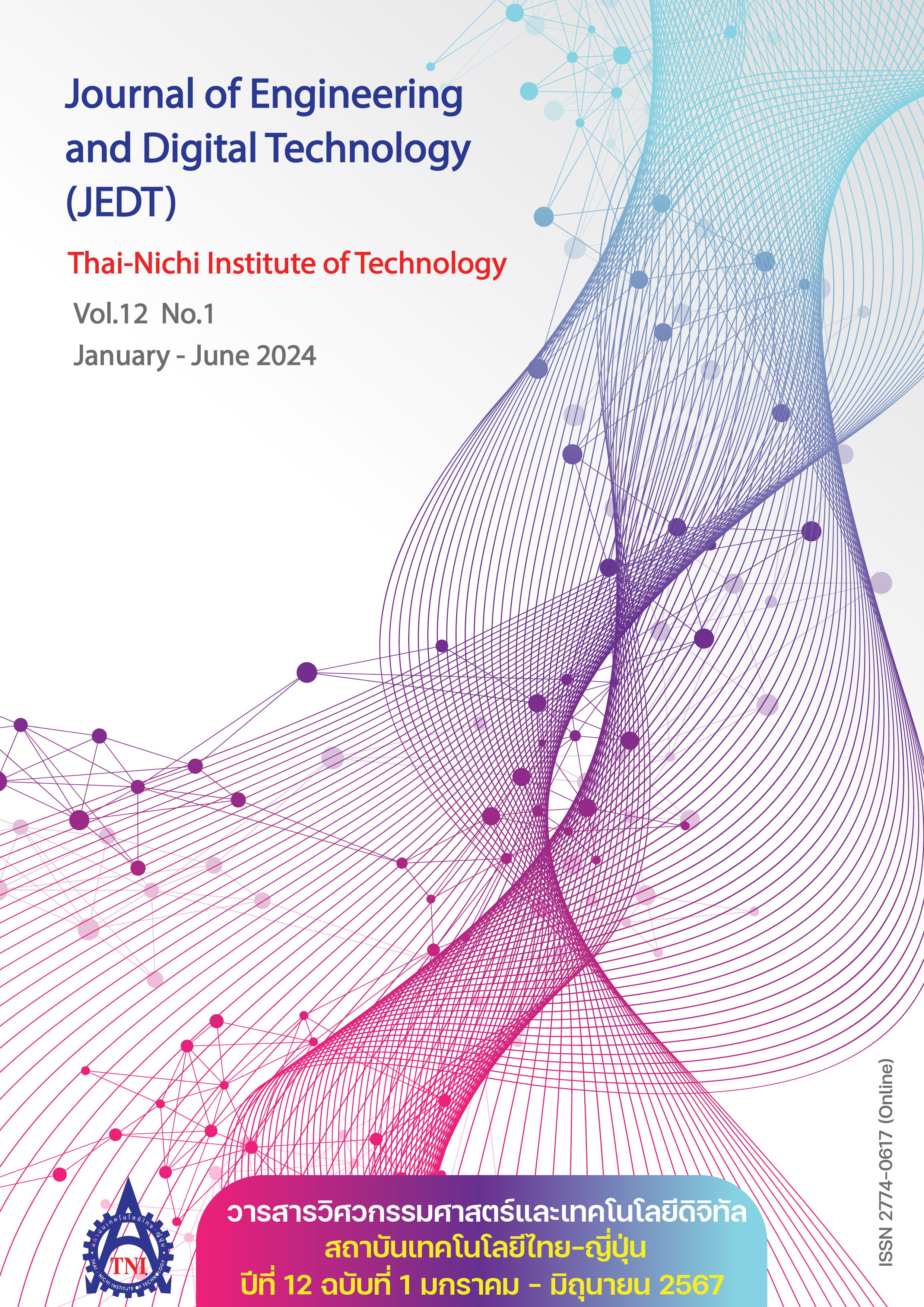การวิเคราะห์ประสิทธิภาพของเครื่องบรรจุน้ำดื่มอัตโนมัติต้นทุนต่ำแบบหัวจ่ายเดียวที่ควบคุมการทำงานด้วยโปรแกรมเมเบิลลอจิกคอนโทรลเลอร์
Main Article Content
บทคัดย่อ
งานวิจัยฉบับนี้นำเสนอการวิเคราะห์ประสิทธิภาพของเครื่องบรรจุน้ำดื่มอัตโนมัติต้นทุนต่ำแบบหัวจ่ายเดียวที่ควบคุมการทำงานด้วยโปรแกรมเมเบิลลอจิกคอนโทรลเลอร์ ซึ่งโปรแกรมเมเบิลลอจิกคอนโทรลเลอร์ถูกใช้ควบคุมการทำงานมอเตอร์ไฟฟ้ากระแสตรงและควบคุมสเต็ปมอเตอร์ของตัวเครื่องบรรจุน้ำดื่มอัตโนมัติ โดยมีหลักการทำงานเป็นขั้นตอนดังนี้ 1) เมื่อนำขวดน้ำวางที่สายพานลำเลียง สายพานลำเลียงจะส่งขวดไปยังจุดบรรจุน้ำ 2) เมื่อบรรจุน้ำจนถึงปริมาตรที่เหมาะสมจะย้ายขวดน้ำจากจุดบรรจุน้ำไปยังจุดปิดขันฝาโดยใช้การหมุนจากสเต็ปมอเตอร์ 3) ขั้นตอนการปิดฝาขวดน้ำดื่ม ทำการขันฝาขวดด้วยมอเตอร์ไฟฟ้ากระแสตรงและกระบอกลม โดยมีเซนเซอร์สั่งการให้กระบอกลมดันลงมาปิดฝาและมอเตอร์ไฟฟ้ากระแสตรงหมุนเพื่อทำการปิดฝาให้เข้าเกลียว และ 4) เมื่อปิดฝาเสร็จสเต็ปมอเตอร์หมุนเพื่อนำตัวขวดน้ำที่ปิดแล้วไปที่สายพานลำเลียงขาออก ทำการทดสอบประสิทธิภาพการทำงานของเครื่องบรรจุน้ำดื่มอัตโนมัติ มาตรฐานการวิเคราะห์ทางสถิติ (analytical statistics) ถูกนำมาประยุกต์ใช้สำหรับการวิเคราะห์ผลการทดสอบของเครื่องบรรจุน้ำดื่มอัตโนมัติ โดยทำการทดสอบทั้งหมด 30 ครั้ง ประกอบด้วย 3 ค่า คือ การหาค่าเฉลี่ยของปริมาณน้ำดื่มที่บรรจุได้อยู่ที่ 597.27 มิลลิลิตร ค่าเบี่ยงเบนมาตรฐาน (SD) อยู่ที่ 2.87 และคารากที่สองของค่าความคลาดเคลื่อนกำลังสอง (RMSE) มีค่า 1.95 แปลผลว่าเครื่องบรรจุน้ำคลาดเคลื่อนอยู่ที่ ± 1.95 มีผลการทดสอบหารอบเวลาการผลิตที่เหมาะสมอยู่ที่ 12 นาที และอัตราการบรรจุน้ำพบว่าสามารถบรรจุน้ำได้เฉลี่ย 8 ขวดต่อนาที ผลด้านการใช้พลังงานไฟฟ้าพบว่าใช้กำลังไฟฟ้าสูงสุด 32.1 วัตต์ โดยใช้พลังงานต่อการทำงาน 1 ขวดเท่ากับ 0.6 วัตต์ชั่วโมง เครื่องบรรจุน้ำดื่มอัตโนมัติที่ได้สร้างขึ้นมีอัตราการเดินเครื่องร้อยละ 99 ค่าประสิทธิภาพการเดินเครื่องร้อยละ 100 อัตราคุณภาพร้อยละ 88.89 และค่าประสิทธิผลโดยรวมของเครื่องจักร (Overall Equipment Effectiveness) อยู่ที่ร้อยละ 88.00 เมื่อเทียบกับเครื่องจักรในอุตสาหกรรมโดยทั่วไปถือว่าเครื่องบรรจุน้ำดื่มอัตโนมัติมีประสิทธิผลโดยรวมในระดับดี และในส่วนของต้นทุนในการสร้างเครื่องพบว่ามีราคาต่ำกว่าราคาขายบนท้องตลาด
Article Details

อนุญาตภายใต้เงื่อนไข Creative Commons Attribution-NonCommercial-NoDerivatives 4.0 International License.
นโยบายการรับบทความ
กองบรรณาธิการวารสารสถาบันเทคโนโลยีไทย-ญี่ปุ่น มีความยินดีรับบทความจากอาจารย์ประจำ และผู้ทรงคุณวุฒิในสาขาวิศวกรรมศาสตร์และเทคโนโลยี ที่เขียนเป็นภาษาไทยหรือภาษาอังกฤษ ซึ่งผลงานวิชาการที่ส่งมาขอตีพิมพ์ต้องไม่เคยเผยแพร่ในสิ่งพิมพ์อื่นใดมาก่อน และต้องไม่อยู่ในระหว่างการพิจารณาของวารสารอื่นที่นำส่ง ดังนั้นผู้สนใจที่จะร่วมเผยแพร่ผลงานและความรู้ที่ศึกษามาสามารถนำส่งบทความได้ที่กองบรรณาธิการเพื่อเสนอต่อคณะกรรมการกลั่นกรองบทความพิจารณาจัดพิมพ์ในวารสารต่อไป ทั้งนี้บทความที่สามารถเผยแพร่ได้ประกอบด้วยบทความวิจัย ผู้สนใจสามารถศึกษาและจัดเตรียมบทความจากคำแนะนำสำหรับผู้เขียนบทความ
การละเมิดลิขสิทธิ์ถือเป็นความรับผิดชอบของผู้ส่งบทความโดยตรง บทความที่ได้รับการตีพิมพ์ต้องผ่านการพิจารณากลั่นกรองคุณภาพจากผู้ทรงคุณวุฒิและได้รับความเห็นชอบจากกองบรรณาธิการ
ข้อความที่ปรากฏภายในบทความของแต่ละบทความที่ตีพิมพ์ในวารสารวิชาการเล่มนี้ เป็น ความคิดเห็นส่วนตัวของผู้เขียนแต่ละท่าน ไม่เกี่ยวข้องกับสถาบันเทคโนโลยีไทย-ญี่ปุ่น และคณาจารย์ท่านอื่น ๆ ในสถาบัน แต่อย่างใด ความรับผิดชอบด้านเนื้อหาและการตรวจร่างบทความแต่ละบทความเป็นของผู้เขียนแต่ละท่าน หากมีความผิดพลาดใด ๆ ผู้เขียนแต่ละท่านจะต้องรับผิดชอบบทความของตนเองแต่ผู้เดียว
กองบรรณาธิการขอสงวนสิทธิ์มิให้นำเนื้อหา ทัศนะ หรือข้อคิดเห็นใด ๆ ของบทความในวารสารสถาบันเทคโนโลยีไทย-ญี่ปุ่น ไปเผยแพร่ก่อนได้รับอนุญาตจากผู้นิพนธ์ อย่างเป็นลายลักษณ์อักษร ผลงานที่ได้รับการตีพิมพ์ถือเป็นลิขสิทธิ์ของวารสารสถาบันเทคโนโลยีไทย-ญี่ปุ่น
ผู้ประสงค์จะส่งบทความเพื่อตีพิมพ์ในวารสารวิชาการ สถาบันเทคโนโลยีไทย-ญี่ปุ่น สามารถส่ง Online ที่ https://www.tci-thaijo.org/index.php/TNIJournal/ โปรดสมัครสมาชิก (Register) โดยกรอกรายละเอียดให้ครบถ้วนหากต้องการสอบถามข้อมูลเพิ่มเติมที่
- กองบรรณาธิการ วารสารสถาบันเทคโนโลยีไทย-ญี่ปุ่น
- ฝ่ายวิจัยและนวัตกรรม สถาบันเทคโนโลยีไทย-ญี่ปุ่น
เลขที่ 1771/1 สถาบันเทคโนโลยีไทย-ญี่ปุ่น ซอยพัฒนาการ 37-39 ถนนพัฒนาการ แขวงสวนหลวง เขตสวนหลวง กรุงเทพมหานคร 10250 ติดต่อกับคุณพิมพ์รต พิพัฒนกุล (02) 763-2752 , คุณจุฑามาศ ประสพสันติ์ (02) 763-2600 Ext. 2402 Fax. (02) 763-2754 หรือ E-mail: JEDT@tni.ac.th
เอกสารอ้างอิง
A. Tarantino, “Introduction to Industry 4.0 and Smart Manufacturing,” in Smart Manufacturing: The Lean Six Sigma Way, New Jersey, NJ, USA: John Wiley & Sons, 2022, ch. 1, pp. 1–19.
L. Zhou and Y. Cui, “The application of PLC control technology in electric automation,” Int. J. Frontiers Eng. Technol., vol. 4, no. 1, pp. 25–30, 2022.
X. Niu, “Application analysis of PLC technology in electrical engineering automation control,” Foreign Sci. Technol. Periodical Database (Abstract Edition) Eng. Technol., pp. 058–059, Aug. 2021, doi: 10.47939/et.v2i8.19.
N. Tanchiwawong, PLC System (Programmable Logic Controller System). Bangkok, Thailand: Technology Promotion Association (Thailand-Japan) (in Thai), 1998.
K. Prewthaisong, “Automatic color sorting machine on conveyor systems controlled by arduino,” (in Thai), APHEIT J. (Sci. Technol.), vol. 5, no. 1, pp. 15–21, 2016.
D. Tailor, V. Kamani, A. Ghetiya, and N. Bhatiya, “Object sorting and stacking automation with PLC,” Int. J. Eng. Technol., vol. 9, no. 3S, pp. 197–201, Jul. 2017.
N. Pipatpaiboon, C. Chaiyakhot, M. Raksamerwong, T. Chiangkhwang, and A. Donmuang, “Design and construction of lid automatic machine for SMEs,” (in Thai), Sakon Nakhon Rajabhat Univ. J., vol. 5, no. 9, pp. 109–118, 2013.
S. Arsaipanich and T. Srinak, “Automatic fish size measurement by image analysis,” (in Thai), in Proc. 1st Conf. Appl. Res. and Develop., Bangkok, Thailand, May 2009, pp. 7–12.
S. Kongsintu, A. Singjan, S. Dumnui, and N. Suksong, “The design of automatic color sorting machine on conveyor systems by arduino color recognition sensor module,” (in Thai), J. Res. Innov., Inst. Vocational Educ. Bangkok, vol. 1, no. 2, pp. 56–68, 2018.
K. Chahine and B. Ghazal, “Automatic sorting of solid wastes using sensor fusion,” Int. J. Eng. Technol., vol. 9, no. 6, pp. 4408–4414, Dec. 2017.
K. Sasidhar, S. F. Hussain, S. A. Safdar, and M. A. Uddin, “Design and development of a plc based automatic object sorting,” Int. J. Res. Scientific Innov., vol. 4, no. 12, pp. 2321–2705, Dec. 2017.
C. Nopphonkrang and P. Tamapan, “Reducing time and increasing the efficiency of bottled water production: Case study of Yang Chum Noi Agricultural Cooperative Plant Limited, Yang Chum Noi District Sisaket Province,” (in Thai), Sci. Technol. J. Sisaket Rajabhat Univ., vol. 2, no. 2, pp. 32–42, 2022.
C. Ruangraksa and P. Sanposh, “Design of automatic soup filling machine,” (in Thai), Srinakharinwirot Univ. Eng. J., vol. 18, no. 2, pp. 17–30, 2023.
J. Phasadutharn, P. Dumrongchai, and C. Satirapod, “Performance test of geodetic GNSS receiver with mems and IMU sensors using network-based GNSS RTK method,” (in Thai), in Proc. 27th Nat. Conv. Civil Eng., Chiang Rai, Thailand, Aug. 2022, pp. 161–169.
P. Dawan et al., “Comparison of power output forecasting on the photovoltaic system using adaptive neuro-fuzzy inference systems and particle swarm optimization-artificial neural network model,” Energies, vol. 13, no. 2, p. 351, 2020, doi: 10.3390/en13020351.
T. Ouypornkochagorn, “Spy OEE: A novel method for getting OEE by operating time characteristic,” (in Thai), Romphruek J., vol. 30, no. 1, pp. 1–24, 2012.
L. C. Ng Corrales, M. P. Lambán, M. E. Hernandez Korner, and J. Royo, “Overall equipment effectiveness: systematic literature review and overview of different approaches,” Appl. Sci., vol. 10, no. 18, p. 6469, 2020, doi: 10.3390/app10186469.


